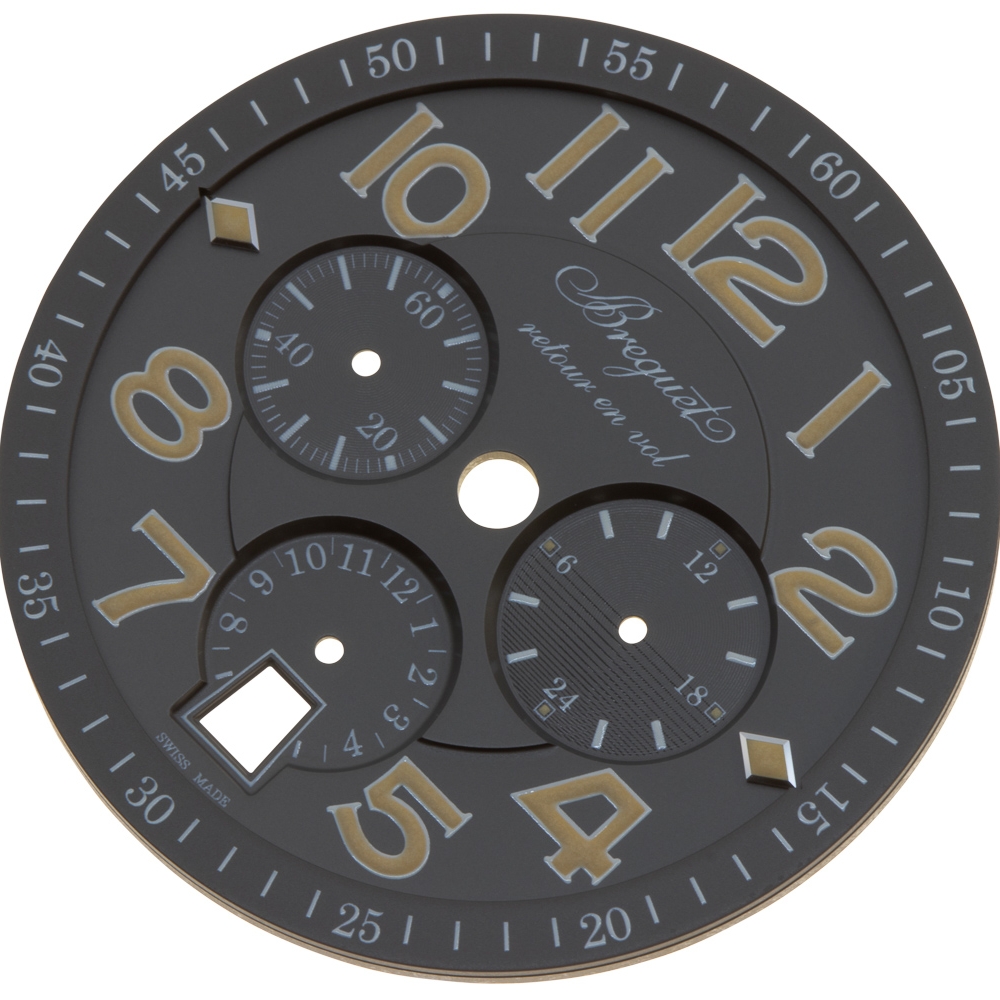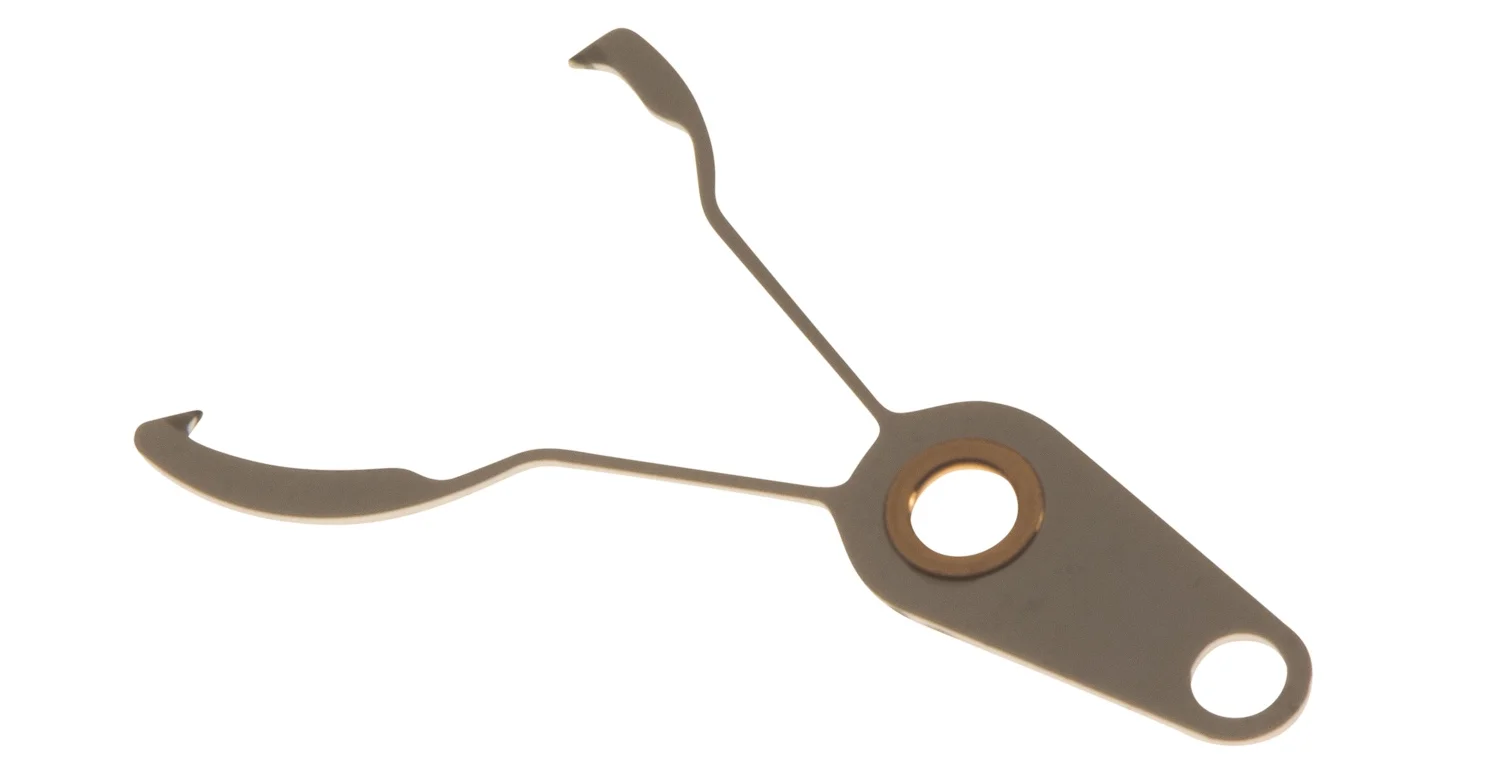The Reason
An original calibre, an entirely integrated chronograph mechanism with the minute recorder centrally positioned to enhance readability, plus a 24 hour time indication at 3 o’clock.
(Launched in 2016)
Functions: central minutes and hours, constant seconds hand at 9 o’clock, central chronograph minute recorder hand and chronograph seconds hand, twelve hour recorder at 6 o’clock, 24 hour time indication at 3 o’clock. Date at 6 o’clock.
Winding automatic Power reserve 48 hours Calibre 584 Q/2 Jewels 26 Frequency 4Hz Escapement Inverted straight-line lever Balance-spring Flat / Silicon Sapphire case back and bezel Case Diameter 42mm Case thickness 15.2mm Water-resistant 100m
Breguet Type XX
The chronograph wristwatch Type XX is the best-known of all timepieces developed by Breguet to answer the requirements of aviation. This direct descendant of the first wrist-chronographs of 1935 was produced only in very small numbers until it won the official approval of the French technical services in 1950. From 1954, Breguet was commissioned by the government to supply it to the French Air Force, the state flight testing centre and the Fleet Air Arm. These watches remained the property of the state and were issued to pilots personally only under exceptional circumstances. The Type XX rapidly became a coveted status symbol, prompting Breguet to produce a civilian version. Sometimes equipped with a time totaliser, and invariably with a retour en vol (fly-back) function, the Type XX is available with slight variations (such as a revolving bezel or different types of winding crown or dial).
The Type XX can be divided into three generations: the first, from the 1950s and 60s, can be recognised by its brushed steel case and its slightly curved shoulders, while the second, from the 1970s and 80s, has a slightly heavier polished steel case with squarer shoulders. Some fifty second generation Type XX were delivered to the Royal Moroccan Air Force in 1975. The third generation, launched in 1995, is distinguished externally by its case with fluted caseband, and unlike its two predecessors is equipped with a self-winding movement. This new Type XX was produced in several variations, with or without date, in steel, titanium or platinum.
In 2010, a limited edition of 1000 was issued to mark the centenary of the French Fleet Air Arm. In the same spirit/style, the Type XXI was launched in 2004, followed by the Type XXII, with a high frequency 10 Hertz movement.
Below, the case back is removed showing the movement held in its movement ring. The case back is held onto the middle of the case using 8 stainless steel screws
The slate grey coloured dial with luminescent Arabic numerals. Additional horizontally machined lines on the 24 hour subsidiary dial to emphasise day and night.
-Retour en Vol- or -Flyback- a function by which the chronograph seconds hand can be reset to zero and immediately started again by pressing once on the push-piece.
The hands luminescence compound marries to the dials colour to evoke a vintage look. The matt finished hand with diamond end is the minute recorder hand.
Movement, calibre 584 Q/2
The film shows the cam controlled system being activated. The upper pusher is for the start-stop and the lower activates the return to zero hammer system. If the lower is used with out stopping the chronograph it will return the hands to zero and upon being released will automatically restart the chronograph.
The rotor is held in place by the central cog-shaped nut which is tightened and loosened by the tool below.
The tool has a specifically set torque, the head will slip once the desired torque is reached.
The rotor turns on a steel and ceramic ball-race. It is made in 18K gold and decorated. The cut out in the centre is to allow the rotor weight to flex if the watch receives an impact, protecting the ceramic balls.
All of the levers are straight grained and their angles polished. Surfaces where there is steel touching steel there is lubrication present. The screw in the centre which has flat sides is a form of eccentric adjustment controlling the penetration between the coupling clutch and the chronograph wheel.
The balance wheel and cock removed showing the pallet/Swiss lever bridge.
The balance assembly, free-sprung, adjusted by timing screws. Silicon balance spring.
The Swiss lever and bridge removed.
The balance wheel (recto-verso) and Swiss lever.
The automatic block in place. The red coloured pinion meshes with the rotors ball race pinion and via an eccentric cam underneath it, milled out of the pinion moves the scissor lever back wards and forwards, this in turn pushes or pulls upon the yellow wheel winding the automatic mechanism. (The pieces are shown further below).
A partial exploded view of the chronograph and automatic mechanism.
The automatic block. The second image shows the extended pinion which links with an additional two wheel train which in-turn meshes with the ratchet wheel and winds up the mainspring.
The winding pinion with cam which activates the scissor lever.
The scissor lever which pushes and pulls the hidden ratchet wheel sandwiched between two discs which guide the scissors beaks.
The wheel upon which the scissor lever drives the automatic mechanism.
The partially dismantled chronograph, with the chronograph return hammer still in place. The return hammers for the minute and the hours are found under the calendar mechanism.
An exploded view of the first parts to be placed on top of the train bridge including the coupling clutch.
The chronograph further dismantled with coupling clutch now removed. The cam in the centre when activated is the basic start/stop function controlling the break and coupling clutch.
The main train bridge which also supports the majority of the chronograph mechanism.
The main train bridge removed. The wheels to the left drive the escapement and balance. The two to the right which are solid link to the automatic mechanism and wind the barrel ratchet wheel.
The dial removed showing the date disc.
The central cover disc removed showing part of the chronograph mechanism. The steel cam assembly under the three legged gold coloured spring is the minute recorder return cam.
The minute recorder system for the chronograph.
The date disc and mechanism removed.
The rapid date change mechanism underneath the primary date disc bridge.
Once the above bridge is removed the stop/start levers for the minute recorder are viewed.
Bottom left shows the pivot upon which the hour recorder hand is pushed.
The hour recorder bridge and mechanism removed leaving only the minute recorder mechanism and setting mechanism for the time.
The chronograph activated.
Summary
A modern complex utilitarian calibre, solid, precise and well balanced with a significant mass of mechanics integrated to an effective result. Combining a strong cam system with all surrounding pieces carefully finished, including the guilloché gold automatic rotor. Many classic elements from previous chronographs have been adopted such as the cam system, but taken to a naturally higher level in relation to function, finish and assembly. The automatic mechanism likewise, taking a classic scissor automatic system consuming minimal space on the balance side of the calibre and reducing the need for lubrication by using beryllium copper and ceramic balls.
Inclined views showing the screwed down crown and the fluting in the centre of the case.
Two of the specialised movement holders made for the calibre.
To learn more about Breguet www.breguet.com









































